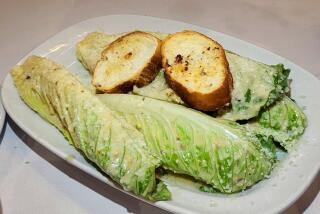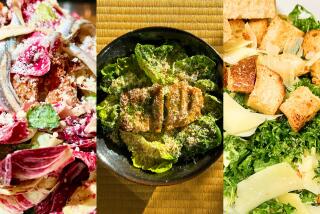Caesar! Origin of the Species
How could a mere salad cause such emotion? --Julia Child, on the Caesar salad
If some of today’s Followers of the Great Caesar Salad were to have been present at the salad’s inception, they’d scowl and say, “Hey, where’s the anchovy?”
The shocking truth is that while a proper Caesar always has anchovy, an authentic one never does. In its original form, Caesar salad was more a culinary tourist trap than a great American food standard, famous for the tableside show that came with the salad, not the anchovy.
Yet it is the anchovy that most Caesar aficionados consider vital; only Caesar wimps ask for their salad sans the small fry. So where did the anchovy come from?
That is the question that sent this reporter into the harrowing world of food history only to come up for air one sleepless week later with no definite answer.
The most common theory involves Worcestershire sauce. The thinking is that Someone, Somewhere Along the Way (a phrase I came across too many times) ran out of Worcestershire sauce (Caesar’s original exotic ingredient), saw anchovy on the list of ingredients and made the brilliant substitution.
“We can’t figure it out,” said Rosa Cardini, daughter of the salad’s inventor, Tijuana restaurateur Caesar Cardini. Cardini envisioned his a subtle salad, but as Rosa pointed out, subtle is exactly what anchovies aren’t.
One logical place to turn was Chasen’s, where the Caesar enjoyed its early popularity in this city. They weren’t much help. “Chasen’s had nothing to do with anchovies or Tijuana,” a restaurant spokesman curtly said. (Anchovies are optional in the Chasen’s Caesar.)
I did, however, discover several conflicting Caesar points of view. There’s the bite-size vs. whole lettuce leaf debate (the original salad was made with whole leaves arranged as finger food), the mushed vs. the sliced anchovy debate (mushed in the dressing gives anchovy flavor to every bite), and the particularly controversial coddled egg debate (some insist the egg should be broken directly onto the lettuce; others can’t stomach the thought). And despite excellent documentation of the first Caesar, I found several odd variations of the original story most accept as fact:
Story No. 1: Common Knowledge. The year, 1924; the man, Caesar Cardini, owner of Caesar’s Place (now Caesar’s Grill) in Tijuana, Mexico. Prohibition was on and floods of Hollywood VIPs poured into the one-time celebrity resort where Cardini regularly cooked up out-of-the-ordinary dishes for his rich customers. His salad was an instant hit.
Story No. 2: The Twist. Beatriz Santini made the first “Caesar” salad in Austria, 1918. Again, no anchovies. Santini’s son, Livio, turned up in Tijuana in 1924, got a job at Cardini’s restaurant and mixed up a batch of his mama’s salad for himself. Before he could finish, a wealthy woman from La Jolla burst into the kitchen, tasted his creation and ordered one for herself. Livio himself told this revisionist tale of the Caesar to The Times’ Barbara Hansen in 1984.
Story No. 3. A Blatant Untruth. Told to Fred Ferretti of Gourmet magazine by a self-described Caesar authority, Joseph Calemme (a.k.a. Monsieur Joseph), of La Fontaine Restaurant in Detroit’s Westin Hotel. Alex Cardini, brother of Caesar, made the first Caesar salad in 1926, not 1924. Alex, who served in the Italian Air Force before moving to Tijuana, called his invention an Aviator salad, and later changed the name to Caesar in honor of his brother.
This story is almost believable-- but for one fact. Calemme insists that a Caesar isn’t authentic unless it has anchovies. And if there’s one thing I’ve learned during this search it is that the first Caesar-lover was no anchovy-lover.
More to Read
Eat your way across L.A.
Get our weekly Tasting Notes newsletter for reviews, news and more.
You may occasionally receive promotional content from the Los Angeles Times.








